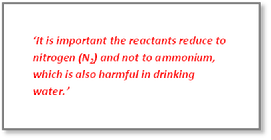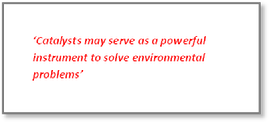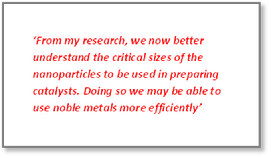| Because of over-fertilization in modern agriculture, nitrate and nitrite levels in groundwater are too high, making it undrinkable for humans. The problem is spread all over the world, in Europe as well as in China. In the eastern region, from which Yingnan Zhao originates, people mostly drink from rivers and lakes. ‘In many rural areas though, people drill wells for drinking water. Here nitrate and nitrite is a big problem,’ Zhao says. He worked on aspects of catalytic treatment: a promising technique. |
Catalysts can be prepared by colloidal (‘glueing’) methods using nanoparticles as a starting point. As the size and shape of nanoparticles can be manipulated easily, under good control, these methods seem advantageous. Catalytic nitrate hydrogenation has been developed as an efficient and inexpensive way, to remove nitrate and nitrite contamination from drinking water, Yingnan Zhao explains. ‘It is important the reactants reduce to nitrogen (N2) and not to ammonium, which is also harmful in drinking water.’ challenges Bimetallic catalysts have been proved with some good results here. However, challenges in using colloidal methods remain tough in this fairly young academic research field, which started about thirty years ago. For example, residing stabilizers on the metal surface are hard to remove completely, inducing complex influences on catalytic reactions taking place on this metal surface. Palladium has been found the most active metal for nitrate/nitrite removal in water. Yingnan studied the effects of the particle size ( between 2 to 5 nm) on the selectivity towards N2 and on the catalytic activity.
industrial partners Yingnan Zhao is optimistic about the chances for catalytic treatment of nitrate contaminated groundwater in the future. ‘I expect catalytic reactions to become economically feasible in about ten years,’ he says. ‘From my research, we now better understand the critical sizes of the nanoparticles to be used in this approach. From these results, researchers can start to optimize the catalysts further.’ Industry seriously considers the advantages of colloidal nanoparticles, for some good reasons: the noble metal can be used with very high efficiency and very low loading; they steer the reactions at room temperature; and the reactors can be portable operated, placed at a corner of a house, e.g. under the kitchen sink. Furthermore: biochemical alternatives are slow still, and membranes are in need of high pressure process conditions and are often vulnerable to blockage and decay. decisive ideas Professor Leon Lefferts encouraged Yingnan Zhao towards ‘independent and good thinking,’ all the way through the PhD project. Yingnan recalls the meetings as very lively and memorable. ‘Though Leon is a busy man, we always planned follow-up appointments, immediately after our meetings, as we enjoyed the discussions, coming up with new ideas. Some of these were decisive. For example, Leon suggested to experiment with catalysts fabricated in our own lab, instead of using commercially available catalysts. This approach led to nice results and significant publications.’ |




